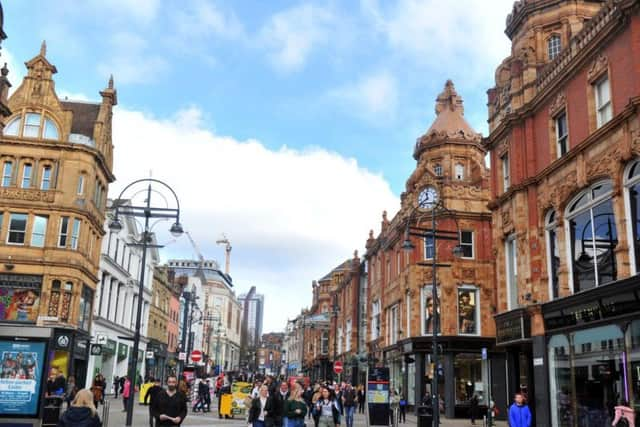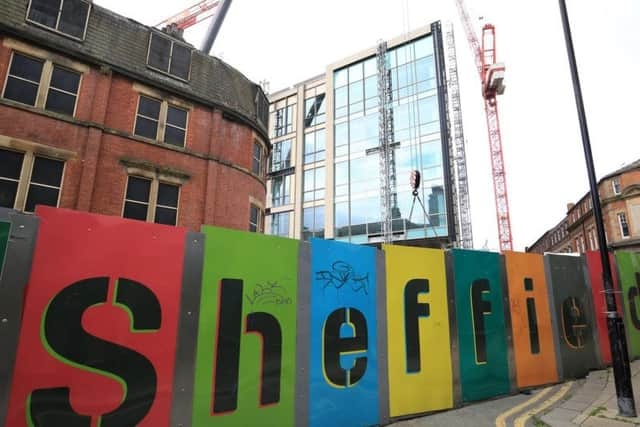High streets in Yorkshire and the North have more empty shops than rest of the UK
and live on Freeview channel 276
On average 12.5 per cent of shops in the North and Yorkshire have been vacant since 2011, compared with ten per cent in the UK as a whole, while footfall has also been dropping at a steeper rate.
According to Springboard, a provider of data and intelligence on customer activity, the figures are part of a long-term trend of decline in visitors to the high street driven by the “digitisation of society”.


Advertisement
Hide AdAdvertisement
Hide AdAnd in Yorkshire the overall average rate for empty shops masks some stark differences across the region. Successful cities like York and Leeds have vacancy rates of 6.2 per cent and nine per cent respectively, while in Harrogate the rate is just under 10 per cent and 13 per cent of shops are empty in Hull.
Diane Wehrle, Insights Director at Springboard, said the trend towards digitisation means that online channels are now used for browsing as well as services like banking and travel.
She said: “This reduces the number of trips made to bricks and mortar destinations which has meant that over the past decade footfall has declined by an average of -1.3 per cent per year. It is within this context that any ambition to reduce the number of vacant units and to increase footfall needs to take place.”


The decline in the high streets - highlighted in a series of reports by The Yorkshire Post this year - has led to calls for changes to planning policies and for local landlords to play more of a role in creating vibrant high streets.
Advertisement
Hide AdAdvertisement
Hide AdBusiness leaders have been lobbying the Government to change the “regressive” system of business rates, which are incurred before any profits are made.
During the General Election campaign, the Conservatives outlined plans to overhaul the business rates system to help create thriving high streets.
They pledged to increase the business rates discount available to businesses with a rateable value below £51,000 from 33 per cent to 50 per cent in 2020-21.
Measures to improve the vibrancy of towns are also expected to emerge from the Government’s £3.6bn Towns Fund.
Advertisement
Hide AdAdvertisement
Hide AdMs Wehrle said retailers and local leaders had options available to them to reduce the number of vacancies and get more shoppers onto the high streets.
She said: “The obvious initiative to reduce vacancies would be to introduce ‘pop up’ retailers – temporary occupiers who broaden the offer in a particular location.
“The key mechanism to increase footfall in a location is implement marketing and promotion – creating a reason or impetus for consumers to visit a destination more frequently or to stay longer whilst they are there.”
Mark Goldstone, Head of Business Representation & Policy at the West and North Yorkshire Chamber of Commerce said the decline was not universally felt and “some locations, especially larger city centres, have held strong”.
Advertisement
Hide AdAdvertisement
Hide AdHe said: “The more vibrant locations are no longer just about retail but more about ‘experience’, there is more diversity of offering with leisure, hospitality, events programmes and other experiential, place based activities which the online sellers cannot compete with.
“We have seen, through the success of Business Improvement Districts for example, that there is a strong appetite amongst business communities to take a more proactive role.”
Plea to landlords as region's cities buck the high street trend
A Yorkshire council leader has called for local landlords to start thinking about how they can play their part in re-invigorating the region's town centres and "see themselves as more than just recipients of rent".
Advertisement
Hide AdAdvertisement
Hide AdRichard Cooper, the Conservative leader of Harrogate Borough Council, said the owners of high street buildings should "charge realistic prices" to help ensure they are re-let as part of a joint effort to create vibrant town centres.
At the end of September, there were 48 retail vacancies out of 489 in the centre of Harrogate, meaning the spa town is outperforming the average for Yorkshire and the North. But Coun Cooper said vacant units were not being re-let as quickly as he would like.
He said: "We are keen to see fairer rents and rates for retailers at levels which support business growth. High street retailers, including our trademark independent shops, need a level playing field to compete with the major online retailers who don’t carry the same overheads.
"Landlords need to start thinking about how they can play their part in re-invigorating the town centre. They need to see themselves as more than just recipients of rent but as a big part of the team ensuring town centre vibrancy. Units will be re-let if landlords charge realistic prices.
Advertisement
Hide AdAdvertisement
Hide Ad“We are taking direct action too, recently purchased a number of vacant shops in Knaresborough, that have sat empty for years - even decades - to try and improve the high street in that area."
On average 12.5 per cent of shops in the North and Yorkshire have been vacant since 2011, according to analysis by Springboard, compared with ten per cent in the UK as a whole, while footfall has also been dropping at a steeper rate.
Yorkshire's big cities are outperforming the rest of the region, with vacancy rates for Leeds, Sheffield and York all below the average.
In Sheffield, footfall has bucked the national trend by rising by seven per cent, while only 4.6 per cent of shops are empty amid what local leaders describe as "vibrant plans of growth and regeneration".
Advertisement
Hide AdAdvertisement
Hide AdThese include Heart of the City II, a new mixed use development bringing in new office space and 400 new apartments to support retailers such as Monki and Weekday.
Despite this success, High Street and Fargate in the city centre have much higher vacancy rates of 24 and 16 per cent respectively. Sheffield City Council hopes to tackle this by providing a 'better green environment' and bring back life to the space above shops.
A spokeswoman said: "Sheffield City Centre retail is changing. The national vacancy average of shop units is a real problem leaving the ‘High Street’ empty and cold. In contrast, a visit to Sheffield shows a very different picture with vibrant plans of growth and regeneration."
York, one of the region's most-visited tourist destinations, the vacancy rate is just 6.2 per cent, due in part to the high number of independent stores. A consultation scheme called My City Centre is shaping how local leaders respond to challenges facing the high street.
Advertisement
Hide AdAdvertisement
Hide AdCouncillor Andrew Waller of City of York Council said: "We know we’re not immune to the growing pressures of internet shopping, decisions by remote hedge funds, economic and social changes and the nationally set business rates.
“We want a city centre which residents love to use, is accessible to all, provides better jobs and allows people to move around sustainably."
In Hull, shop vacancy rates have dropped but are still 13 per cent in the city centre. The city council is bidding to bring unused floorspace back into use on Whitefriargate and the Old Town area.
A spokesman said: "Regeneration proposals are currently being developed to diversify the retail offer with new vibrant, multi-use spaces to support leisure and cultural uses."
